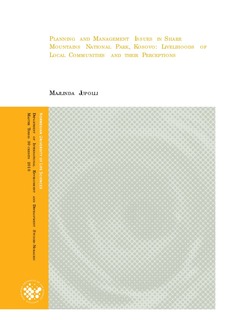| dc.description.abstract | The establishment of protected areas in many countries has included restrictions on the use of park resources by local people, in some cases leading to further environmental deterioration. The research was aimed at exploring whether natural resources in Sharr Mountains National Park (SMNP) in Kosovo are managed in a way that contributes to a sustainable development process combining conservation and development as well as engaging communities to participate in conservation and development activities. Further, the study was aimed at analyzing the present day livelihood situation of communities living adjacent to SMNP. It also investigated local people’s perceptions and attitudes towards conservation measures and government policies as well as their constraints to improved livelihoods. To accomplish this, a case study approach was adopted involving both qualitative and quantitative research methods and four villages adjacent to SMNP were purposively selected. Household survey was carried out and a total of 60 questionnaires administered. Stratified sampling technique was used to select the sampled households. Focus group discussions and key informant interviews were also part of the data collection methods. The study reveals that in Kosovo, the chief objectives of Sharr Mountains National Park management have been limited to defining parks’ legal status, demarcation of boundaries, fire control measures, protecting flora and fauna and to some extent, providing visitor services. The role that national park could play in supporting local livelihood systems, has so far been neglected. Local communities are still seen as the principal ‘threat’ to forests so that they have been denied access to most important forest products such as fuelwood. This has increased economic insecurity among the local communities and generated antipathy towards conservation measures. Further, study indicates that local people living adjacent to SMNP do not per se actively participate in management decisions and land-use policy. Participation as reported by respondents concentrated in the two lower levels of Pretty’s typology.
The data also reveal that the main resource endowments are land, labour and forest. The most important income source among the sampled population is agriculture followed by off-farm activities. Environmental income represents a relatively significant income source with an average contribution to household income of some 12.5 percent in the population sampled. The main sources of environmental incomes are fuelwood, timber, mushrooms and medicinal plants.
The major constraints faced by households in their decreasing order of importance were: lack of available market and low market prices for their traditional products, access to forest products from the park, land access problems and access to financial capital. The findings also confirm that almost 62% of the local people have a negative relationship towards the National Park due to the presence of park guards, but this does not influence their positive perception of 69% towards the Park due to conservation and cultural reasons. Further, the findings indicate that 74% of the local people are willing to participate but have a negative perception of government policies with respect to local participation due to corruption and restricted user rights. The local people perceive participation as a means of the state to achieve its political and policy goals rather than a right for local communities. Further, lack of communication and little experience on participatory management does not increase the hopes for a collaborative future between the users and the protectors. | en_US |
